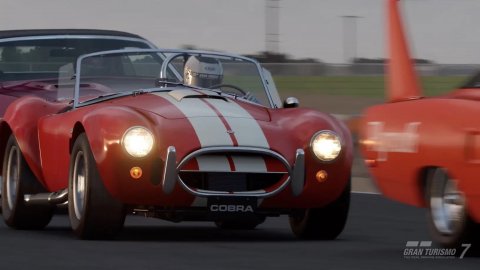
Gran Turismo 7
The prices of the legendary cars of Gran Turismo 7 are dynamic and therefore will fluctuate over time, according to estimates by Hagerty, an insurance company specializing in the valuation of classic cars. In this way the cost of these cars will constantly reflect their real market value.This peculiar collaboration also includes the presence of the Hagerty brand in the Gran Turismo Career 7. Even the CEO of the company, McKeel Hagery, appears in the game as an avatar that guides the player, offering historical and educational insights into some of the historic cars available for purchase in the "Hagerty Collection" dealerships, ranging from the cheapest 150,000 credits to the most expensive 20 million credits.
Gran Turismo 7, the CEO of Hagerty appears in the game The most intriguing detail of this collaboration, however, is precisely linked to the dynamic prices of the legendary cars of Gran Turismo 7. At the moment we do not know exactly at what intervals they will be updated, but how you can guess their cost will fluctuate over time, with blue and red arrows to indicate the market trend.
This is certainly an interesting idea, however it might make some players turn up their noses, especially after the numerous complaints about the excessive price of Gran Turismo 7 microtransactions.
Source You've noticed errors ?
Gran Turismo 7’s Microtransactions Are Totally Out Of Control
Gran Turismo 7 will charge as much as $40 for a fancy car.
Credit: SonyYou might think paying $70 for a video game would be enough, but you’d be wrong.
While I have no problem with actual DLC or even some cosmetic items in premium pay-to-play video game item shops, there comes a point when we must say enough is enough.
Gran Turismo 7 appears to be one of those instances.
Chris Scullion, writing at VGC, has a good rundown of just how excessive the new racing game’s shop is—and how manipulative its pricing schemes are. He notes that the shop was not live when reviewers had access to the game, making it difficult for anyone playing the game before release to have a clear understanding of what the post-release revenue model would look like.
In the game, you can purchase credits with real money to then purchase items in the game itself, including cars and vehicle upgrades. These credits come in four amounts. As per usual, buying more gets you credits cheaper. Here are the four tiers:
In Gran Turismo Sport, you could purchase vehicles with real money rather than credits, with cars ranging from $0.99 to $4.99. Now, prices have gone up and in order to make a purchase you need to buy credits. But credits don’t necessarily come in the right size package.
“A large number of hi-spec cars also cost 1,000,000 credits, but there’s no option to buy 1,000,000 credits from the PlayStation Store,” writes Scullion.
“As such, players running low on credits looking to buy a million-credit car will have to buy 750,000 and 250,000 credits for a total cost of $15, or 2,000,000 for $20.”
This is pretty devious, modeled after the anti-consumer practices in the mobile gaming industry.
Scullion also notes that “a Porsche 919 Hybrid 16, which can be bought for $2.99 in Gran Turismo Sport, can only be bought for 3,000,000 credits, which would require the player to spend at least $40.”
Apparently in a pre-release State Of Play video some legendary cars cost as much as 20 million credits—$200 in real money. That’s . . . crazy. Crazy greedy. While those cars haven’t shown up in the game yet—and maybe never will—it’s still pretty galling.
I generally have mixed feelings about item shops in premium games. For instance, I find the current Call Of Duty model—which has an Item Shop with character skins, weapon blueprints, other cosmetics etc. coupled with an optional Battle Pass—much better than the previous map-pack based revenue model. It’s all optional and all the post-release maps and weapons are free to all players (though some weapons have to be unlocked with rather tedious challenges).
This keeps the players all on the same page rather than locking out some players from DLC maps. Players who decide to buy skins for Operators or fancy weapon blueprints from guns they can play with for free are making a choice and one that doesn’t really impact gameplay (though some of those Blueprints do give advantages).
This is all also much better than gambling-based loot boxes . Everyone made such a fuss about after Overwatch popularized that trend that most games have abandoned them altogether, and good riddance.
Still, when you see game publishers selling vehicles in a game like Gran Turismo 7 for this much money, you can’t help but think things were better back before all of this, when you just expected everything to be in the game from the get-go. Expansions with actual new content, sure. We’ll pay for those happily enough. They cost a lot to develop and release. But cars in a car game?
Fuhgeddaboudit
Credit: ParamountYou can follow me on Twitter and Facebook and support my work on Patreon. If you want, you can also sign up for my diabolical newsletter on Substack and subscribe to my YouTube channel.